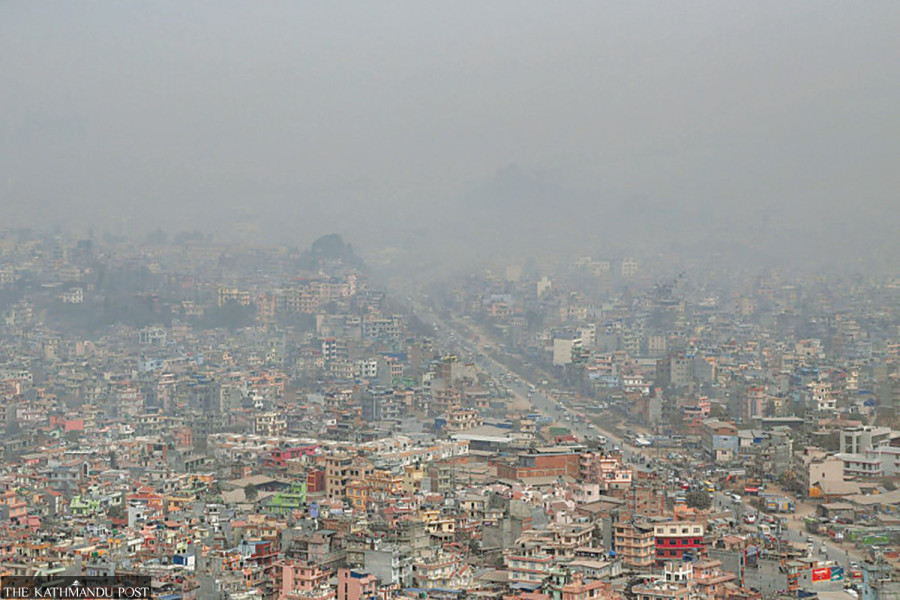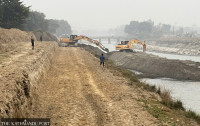National
Season receives record-low rainfall
Experts say shifting rainfall patterns have led to increased pollution, forest fire incidents, reduced agricultural yields, and fueled internal and external migration.
Arjun Poudel
Nepal has witnessed just 11 millimeters of rainfall since December 1, which is significantly below the usual winter average of 60.1 mm. The Department of Hydrology and Meteorology said that six out of 10 past winters witnessed below-normal rainfall—12.5 mm, 14.4 mm, 17.6 mm, and so on.
The country witnessed 136mm rainfall in the winter of 2019-20, and in the winter of 2018-19, it received 108 mm of rainfall, both of which were significantly higher than what is considered normal.
“The country mostly experienced dry conditions with light scattered rains in some hilly places with light snowfall over the higher altitudes,” said Sudarshan Humagain, an official at the department. “Drought-like conditions for a long time and excessive rainfall in the winter, which are extreme weather events, have become the new normal of late.”
According to a new report issued by the department, the cold and dry weather dominated the latter half of December. The daytime temperatures were higher than normal, while nighttime temperatures were cooler in the northern regions and warmer in the southern regions of the country.
Most parts of the country recorded above normal maximum temperature while isolated parts across the country recorded near-normal to below normal maximum temperature during December.
The Eastern Tarai experienced warmer maximum temperatures than western parts. Additionally, certain isolated areas within the Madhesh Province and Koshi Province recorded monthly maximum temperatures higher than 27 degree Celsius. Gaur station of Rautahat district recorded the highest monthly maximum temperature of 29.8 Celsius.
Sudurpaschim Province, eastern half of Gandaki Province and Lumbini Province, Bagmati Province, Madhesh Province and south-western part of Koshi Province faced extreme drought conditions (below normal precipitation by 70 percent) in December. Similarly, southern and western parts of Karnali Province, central parts of Lumbini Province and some central parts of Koshi Province were affected by moderate to severe drought conditions, according to the department.
“Precipitation data of the past few years show that winter rainfall is in decreasing trend,” said Dr Indira Kandel, a senior meteorologist at the department. “What is concerning is that the rainfall pattern has been shifting. Winter rainfall, which used to occur in January or in December-end, started to occur in February last week.”
Nepal has been at the receiving end of the worst effects of the climate crisis and has witnessed multiple extreme weather events over the past decade and a half.
Evidence suggests that the maximum temperature in Nepal is rising faster, at 0.056 degrees Celsius a year, compared to the global average of a rise of 0.03 degrees Celsius a year.
Experts say extreme weather events—excessive rainfall in a short time, continuous rain for several days post-monsoon, dry spells and droughts, below-average precipitation and above-normal temperatures in winter—have become more frequent in Nepal in recent years.
Scores of studies and scientific analyses over the decade, and more recently, the IPCC report have warned that Nepal is one of the most vulnerable countries to climate change and it takes more than a business-as-usual approach to tackle the adverse impacts of the climate crisis.
Climate scientists say the relevant authorities are too slow to take measures to address the problems caused by erratic weather events.
“A lot of things need to be researched and investigated in our context. We don’t have a weather station in the high altitude,” said Kandel. “We should start exploration of unexplored things and maintain data of weather events to predict future events. This is a high time to increase investment in scientific research and strengthen infrastructures.”
Experts say due to drought-like conditions for a long time, farmers dependent heavily on rainfall to cultivate their winter crops have been affected the most. They say that below-average rainfall will certainly affect the production of food crops, which means food shortages and inflations.
“Winter rainfall has been in decreasing trend for many years, which incurs several direct and indirect impacts,” said Dr Binod Pokhrel, a climate expert who is also an associate professor at the Central Department of Hydrology and Meteorology at Tribhuvan University. “Air pollution level rises affecting many people, farmers get a direct hit due to reduced agricultural production, and forest fire incidents increase.”
As climate disasters fueled by erratic weather patterns become more pronounced and frequent, experts say another crisis has been brewing over the years—climate displacement, both internal and external.
Despite visible impacts of the climate crisis, authorities are slow to recognise the impacts, most experts, the Post talked to agree.




 10.12°C Kathmandu
10.12°C Kathmandu















